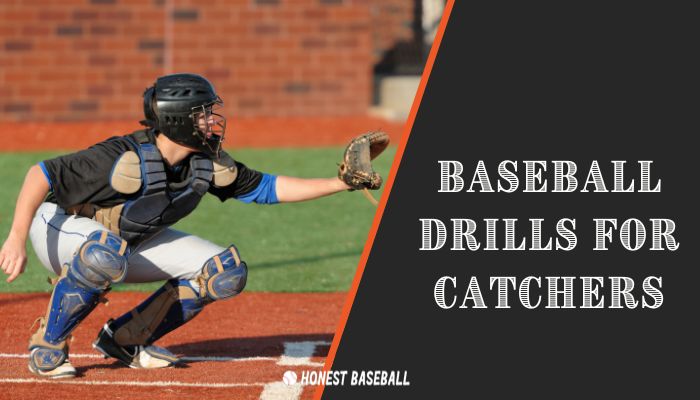The position of catcher in baseball is often regarded as the most difficult on the field. Just take a moment to consider their perspective. Maintaining a squat position with knees bent for an average of nine innings or more.
The position of catcher is one of the most chaotic in baseball since it requires frequent catching of hundreds of pitches and sometimes being struck by the bat and ball. To master and play the catcher position, drills for catchers are the foundation.
By the way, as a catcher, you have to do a lot of stuff in terms of drills and practice. A catcher basically needs to master three basic things- Receiving, Blocking, and Throwing.
Since being a youth baseball coach, I will help you with how to function for these types of catcher drills. So, get ready, and leap for the practice.
Why Do You Need Drills?
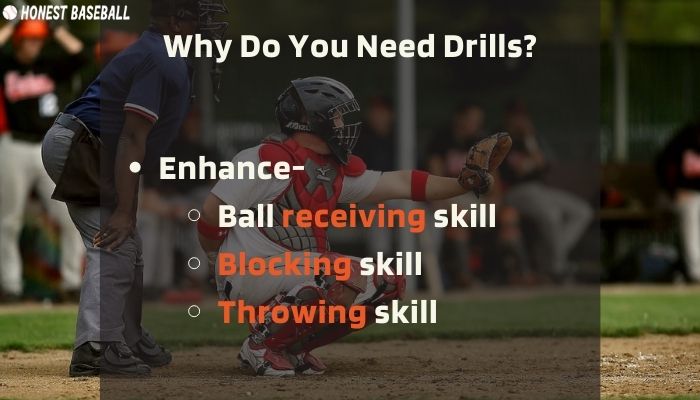
As I mentioned above, drills are the backbone of your skills. Whether you are in MLB, youth leagues, or in any other professional league, drills must be in your daily routine. Whether you are in the batting cage or in the backyard of your home, the drills help you to boost your skill level in no time.
In the school of thought for any industry, there is a proverb,
“crawl before you can walk, walk before you can run.”
So, you have to advance to the pick level of your catcher’s position gradually with precise steps by practicing. Especially as a catcher, you must do it with more details. Because this is the most involved and important position in the diamond.
Drills will improve your,
- Ball receiving skill
- Blocking skill
- Throwing skills.
The drills, with proper practicing, will make you the master of the catcher’s box and build you a complete catcher.
Receiving Drills for Catchers
Okay, without more ado, we are just going to get to the point. First, I will talk about the receiving drills a catcher can do with the help of the coach. Here you got to go with some effective receiving drills.
To start receiving drills, you have to go through some warm-ups.
Warmup Drills- Ease the Feel and Hand Coordination
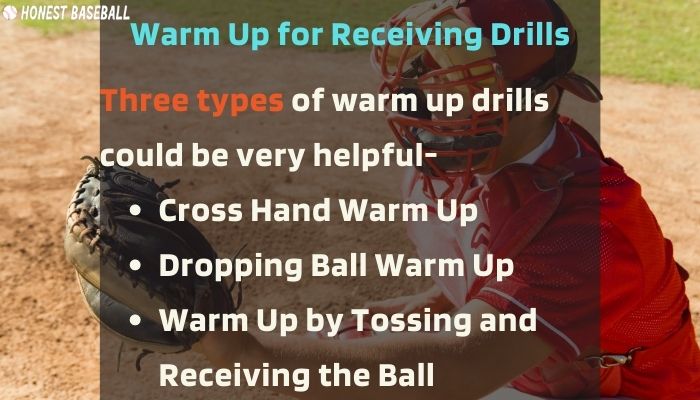
Cross Hand Warm Up
- Take a ball in each hand. Keep the hands at the should height level.
- Release the balls at the same time
- Don’t let the balls fall down the surface
- Since the balls are falling straight down to the surface, catch them with cross arms before touching the ground. This will ease the hand orientation.
Dropping Ball Warm Up
This warm-up needs to be done with the help of a partner. In this case, your coach will be your partner or anyone from the group. By the way, do it with another player from the group. This will help to repeat the practice between you two.
- The partner will take two balls in two hands
- The catcher/player will stand on his knees’ squat
- The partner with the ball will release the balls randomly
- The catcher will catch the falling ball before the ball gets on the ground.
Warm Up by Tossing and Receiving the Ball
In this warm-up, you and your partner will squat down facing each other at a distance of 5 feet. Both of you will be in the receiving position.
- From this posture, you and your partner will both throw the ball to the other person at the same time.
- Take possession of the ball that is in front of you. Please make use of your thumb, index, and middle fingers.
- Toss the ball to the left and right side randomly. Hop for the ball at the same time.
Additional Read: Baseball Drills For 10-Year-Olds
Main Courses of the Receiving Drills
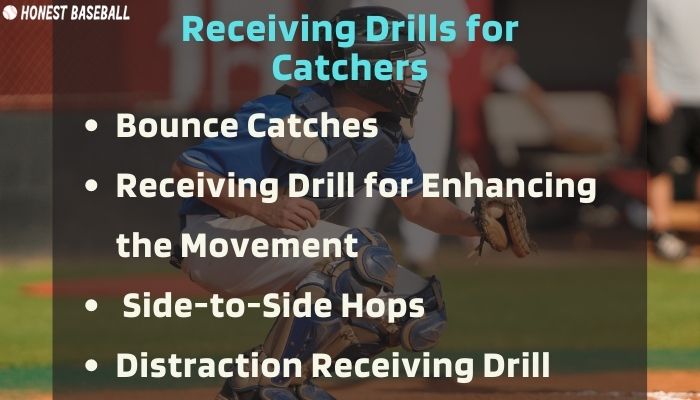
Now it’s time to get into the deep of the receiving drills for the catcher. I will suggest some receiving drills here. By the way, these are not the last words. You can do several drills with the help of your coach.
Different coaches might have different strategies as well.
Bounce Catches
The bounce catches drill is the most common receiving drill for catchers. This is as simple as you think.
- The coach will hop the ball toward the catcher.
- After the coach has thrown the ball, it will be caught by the catcher as soon as it has been thrown.
- The length of the ball’s hop might be either lengthy or short.
- The catcher will instantly release the ball after catching or receiving it and then watch for the next hop once the ball has fallen to the ground.
This receiving drill enhances the catcher’s reflex and the ability to catch the ball easily.
See Also: Baseball Drills for 8-Year-Olds | Fun Baseball Drills
Receiving Drill for Enhancing the Movement
Now, the throw will be faster than the bounce catches by the coach. As a catcher, take your stance for the ball.
- In this drill, the coach will use more fluffy or Wiffle balls. This could be a tennis ball, by the way.
- In order to advance the clip more quickly, the coach will use a tennis racquet to strike the ball. The ball will pick more speed and movement as it travels closer to the catcher.
- Because the primary objective of the ball is to acclimatize the catcher to a quicker pace. To succeed, the catcher must pay closer attention to the ball and catch it with a quick reaction.
- Maintain your concentration on the ball and take it without hesitation.
Receiving the Ball with Side-to-Side Hops
This time; there will be a change in the ball’s movement. The ball will now be thrown side to side for catching and enhancing the catcher’s reflex.
- Set your squat position on your knees
- Hop your hands to the right and left side out of the strike zone
- The coach will throw the ball out of the strike zone, you have to react to the ball as fast as possible.
- The coach can pitch the ball with a long or short hop
- Catch the ball on the right or left side. Freeze yourself and try to understand the ball, body, and glove’s position.
- After analyzing the positions of your glove, body, and ball, let the ball fall down and be ready for the next pitch to receive.
Distraction Receiving Drill
This is a little complex and critical drill. The drill is mainly taken place due to enhancing the concentration and reflex of the catcher.
- Squatting low with knees bent, the catcher will be in a position to receive the ball.
- The coach will cover the catcher’s eyes with a towel while holding the ball in front of them.
- The use of the towel serves the purpose of diverting the attention of the catcher.
- The catcher will be blindsided when the coach pulls the towel from his line of sight.
- The catcher is responsible for locating the ball and snatching it as quickly as feasible.
Blocking Drills for Catchers
There are different types of blocking drills you can go through to enhance your catching skill. Here are some of the efficient blocking drills for a catcher should go through.
Lateral Blocking Drill
This is a basic drill for blocking. You have to follow the following procedure to practice this drill.
- Take up a blocking stance and position yourself.
- The distance between you and the coach will be around 10 feet.
- Your position will determine whether the coach rolls the baseball to your right or left side.
- You should guide your glove inside the block so that it may reach the rolling ball.
- Be sure that you are positioned lower to the ground. Try to avoid going up and down. This is the incorrect approach to take.
- If you lift your whole body off the ground and rush for the block, the ball can sneak past your legs and into the opening. It is possible for it to occur when you are in the air.
- Simply assume the catching posture and move your glove closer to the block while keeping your body lower.

Block Timing Drill
Block timing drills could be taken place with any other drills.
- The coach will be closer to the catcher in this drill
- The catcher will stance in his catching position
- The coach will roll the ball in no time
- The catcher has to block the ball in his position with a sudden reflex.
Note: In this block, the catcher will not get much time. The objective of the drill is to develop the reflex and get down on the ground at the right time. Your knees should be on the ground as the ball bounces. Don’t do it after the ball bounces or before the ball bounces.
By the way, the coach will throw the ball in different dirt at different paces.
See the Baseball Drills for 7-year-olds | Coach Preferred
Block Receive Drill
This block receive exercise is a bit of a variety of strike work and dirt ball work. This exercise is also known as the “react block” drill in certain circles. Because you have to respond appropriately to the ball, which may arrive in a variety of positions.
There are occasions when a large number of novices attempt to cheat in this practice by just posing with a block position.
However, since you are now occupied with the block receive transaction, you will need to take up your backup position. You will get either a strike or a dirt ball from the instructor or the partner, and you must respond appropriately to the ball.
That means don’t be static during the block receive drill. Respond accordingly to the strike and rolled dirt balls.
You can watch the following video for these drill ideas.
Note: Mastering the blocking drills distinguish baseball player from novice to professional. A masterly blocking ability enhances confidence, as well as the skill of a catcher.
It is possibly a mark of honor that distinguishes an adult from a youngster in this regard.
For a baseball catcher, good catcher gear is a must. There are many good catcher gear. We have covered some great catcher gear like Evoshield catcher's gear and Easton Force Catchers' gear. As a safety concern, you might check them out with a detailed review.
Throwing Drills for Catchers
The ultimate goal of a catcher is to throw the ball to the first base or to the pitcher to out the baserunner(s). In this regard, having true throwing capability is a must for a catcher.
With a great throwing ability, you can compete to sustain the team, by the way. Here are some basic and must drills for improving a catcher’s throwing.
Ball Exchange Drill
The very basic drill of throwing is to transfer the ball from the gloved hand to the throwing hand. This drill could be called a transfer drill or exchange drill.
You can do it with a mini glove if you are new. But I would suggest you use your real glove. The goal of this drill is to fast turn your glove into your throwing hand.
- Lengthen the gloved hand in front of you to grab the ball
- Turn the glove naturally and pull the ball with your throwing hand to the throwing position
- Concentrate on performing a hand-driven or elbow-driven takeout in order to get the throwing hand into position for throwing.
Note: don’t expect the ball will come square every time. You have to widen your hand 360° to receive the ball→transfer the ball through the direct line to the throwing hand→and pull back the throwing hand to the throwing position.
Do it through the shortest and fastest route possible. Keep the practice on for 3 to 4 minutes.
The Line Footwork Drill
You must have the right stance, move right, and throw the right. For these, footwork is one of the most crucial aspects of learning.
The line footwork drill will help you to improve your pop-up from your stance and regain the ground in a line.
- Take your catcher’s stance
- Pop up front the ground while receiving the ball
- Lay down your leg in the line of throwing. If you are a right-hand thrower, your left leg will be in front, and vice versa.
- Try to improve keeping control of your body and throw the ball.
Pop-Up Time Decreasing Drill
This drill will help you to decrease the pop-up time so that you can throw the ball in the shortest time possible. This drill is almost the same as the line drill.
Here you have to do a little extra handwork along with the footwork.
- Take catcher stance
- Allow the ball to come and just grab it from your position
- Don’t pull your hand back
- Use the momentum to turn the glove and transfer the ball
- Throw the ball as fast as you transfer it.
Note: Do this for 5 minutes at a time.
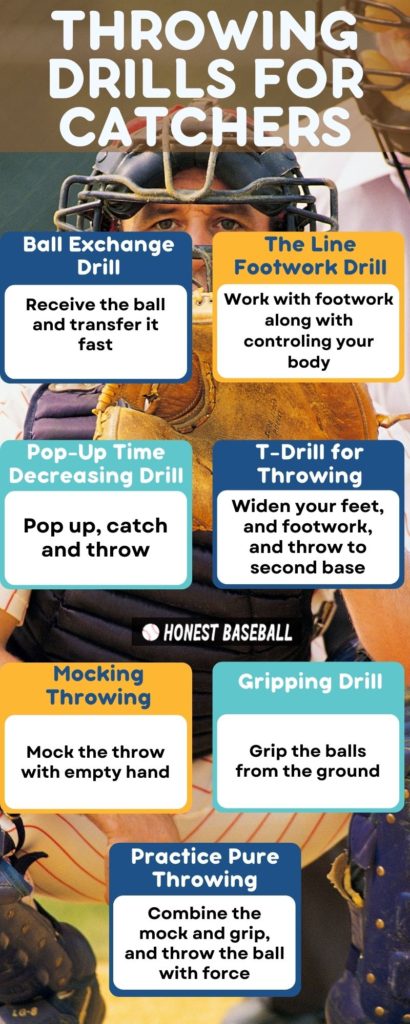
T-Drill for Throwing
One of the fundamental drills for footwork and throwing combination is the t-drill. It is one of the most accepted and productive drills that you could do as a catcher.
For this, you have to make an imaginary T, or draw a T on the practice ground with lines.
- The idea is you center yourself over the long part of the T in the middle. Widen your toes to the two parts of the T-head
- Get your catcher stance
- You have to get into your action stance with the ball into the glove
- Use the T as a point of reference and get the direction straight toward the second base
- Make your toes in line to the straight line of the T and throw the ball straight to the second base.
Note: Make your JAB step short, and make sure the foot is not behind the T-head line. Do it for 5 minutes on a regular basis.
Mocking Throwing
Mocking the actual throwing would enhance and develop your throwing mechanism.
- Be on your left knee if you are a right-hand thrower
- Practice pulling out the ball from the glove and throwing it. Actually, it would help if you did this without the ball. Just pretend to do this, but not actually
- Check how your hand reflex and what your final release point is. Be assured that you are feeling okay with the release point
- Start the drill slowly, and utilize your highest throwing speed gradually.
Note: Do this drill for at least 5 minutes regularly.
Catching is one of the most prominent skills in baseball. Aside from this, baseball is a game of skills. You can check out our guide on Basic skills in baseball to learn about other skills.
Gripping Drill
Gripping the ball is one of the most important aspects of throwing. Without a proper grip, you can’t produce the right motion and speed while throwing.
It’s very easy to do.
- Get on the ground on your knees
- Put some baseballs, softballs, or tennis balls in front of you
- Put them on each side- right, and left
- Start practice picking a ball with a four-seam grip
- Pick a ball from each side randomly.
Note: This drill will help you to get a proper grip in the fastest time. Do the drill daily for at least 3 to 4 minutes.
Practice Pure Throwing
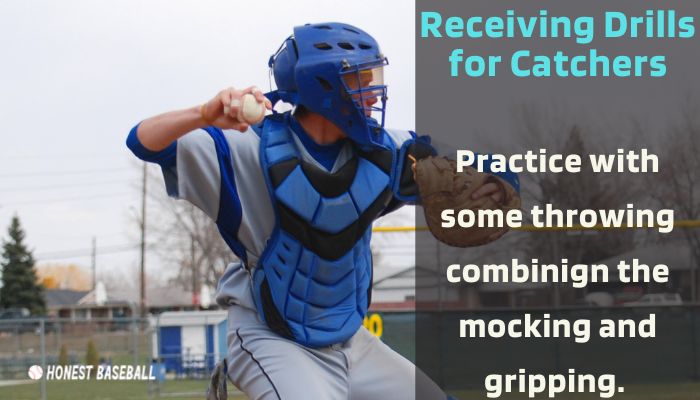
It’s time to combine mocking and gripping. Some pure throwing practice would be the final step, to sum up things.
- Set up a throwing net in the ground and take your place 90 feet distance to simulate the first and third base distance (You can also set 127 distance for simulating the second base from the catcher’s box)
- Now, get your catcher stance and combine the grip and mocking throw
- This time, do some real throws. Don’t limit yourself only to mocking
- Get in the action by throwing the ball to the throwing net.
Note: Do a minimum of 20 throws in each session. Take rest for 5 minutes, and perform the practice 5 times in a cycle. This drill will enhance your throwing accuracy and mechanics. You can also use a wall if you can’t manage a hitting net.
Frequently Asked Questions
- What are the 3 skills that a catcher should be familiar with?
Receiving, blocking, and throwing are the three most fundamental abilities required of a catcher. These three categories include all possible skill sets. In addition to these two talents, a catcher has to be able to bat, run the bases, frame pitches, and perform other duties.
- How should a catcher hold his glove?
In order to properly catch a ball, the catcher’s fingers and glove should be pointing upwards. As a consequence of this, the glove will be open toward the approaching ball, making it much simpler to catch it. Because an open glove target is created as a result of the tucked elbow caused by this posture.
- Why do catchers run slow?
The defensive position of the catcher is considered to be the most prestigious of all others. It may be interpreted in a variety of ways. Additionally, catchers are required to wear a significant amount of equipment, which significantly drains their energy.
As a consequence of this, they often have to make significant sacrifices in terms of their batting ability in order to catch well.
Final Note
There are several drills for catchers. They all work to improve the catchers’ receiving, blocking, and throwing capabilities. However, regular practice with drills must be tried.
The coach needs to implement regular drill sessions so that youth catchers can improve themselves in every sector. Also, having sessions in systematic ways is preferred. Don’t do these all in an unorganized manner.
You Also May Like:
7 Best Baseball Bats for Self Defense – The Walking Dead Bats
How Many Stitches are on a Baseball? 216 or 108?
Best baseball Helmets To Choose In 2022
How To Practice Pitching Alone For Baseball?
Baseball Field Overview | A Brief Guide To Baseball Fields | Honest Baseball

Hello everyone. My name is Jason Butler, and I live in California, America. I was a professional AAA Minor League Baseball player. I lost my chance of playing MLB for injury issues, but I did not lose my love for baseball. I attended the coaching training program and am now working as a coach in a small school in San Diego.
I always love to share my experience and knowledge if that can help you. Play baseball, and stay fit.
